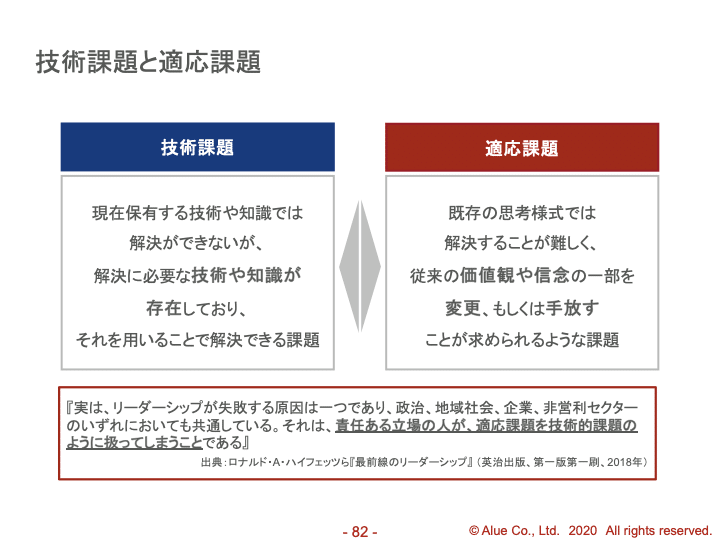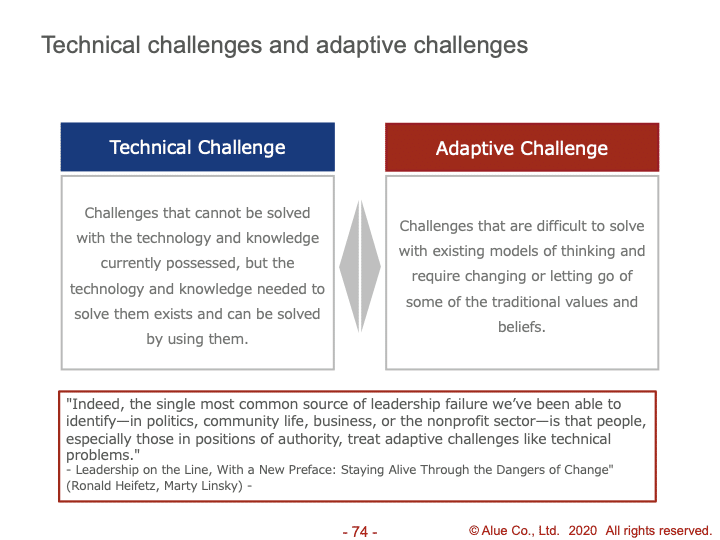
変われないリーダーに共通するたった一つのこと
前回の記事では、改善・イノベーションは、最初のステップである「問い」をいかに適切に立てられるかにかかっているということ、そしてその「問い」はその人のモノの見方に左右されるということをお話ししました。
今回の記事では、変われないリーダーに共通することを題材として、モノの見方の重要性についてお話ししたいと思います。
変われない根本原因は思考モデルにある
変われないリーダーや組織について、次のような声がよく聞かれます。
▼リーダーが過去の成功体験に捉われて新しい考え方や価値観を受け入れようとしない
▼目の前の業務に忙殺されており、新しいことに取り組む余裕がない
▼今のままでも何とか生き残れると思っており、顧客ニーズの変化や技術の変化に追いつくことができていない
みなさんの中にも、同じようなことを感じている方もいらっしゃるかもしれません。
このように書いている私自身も、これまでこのような指摘をたくさん受けて参りました。その度ごとに心が落ち込むと共に、「そんなこと言っても、こんな事情やあんな事情がある」というような言い訳とも言い逃れともつかないようなセリフが心の中に浮かび上がってきますが、一方で、「あ、その通りだな」と観念する気持ちも感じてきました。

こういった課題は何に起因し、どうすれば解決できるのでしょうか?戦略立案や組織開発の方法論を学べば解決するでしょうか。あるいは、コンサルタントなどの専門家に相談すれば解決するでしょうか。
それらが助けになることはあります。でも、それだけでは根本的な解決にはならないことが多いと思います。
なぜなら、人や組織の根本的な思考モデルそのものが変革を妨げる原因になっている場合が多いからです。このような場合、方法論を学んだとしても、価値観や信念体系などの思考モデルが妨げとなってうまく取り入れることができません。要するに、方法論の問題ではないのです。
例えば、新しい価値観を受け入れようとしないリーダーは、自分の上司の考え方に従うことに固執しているのかもしれませんし、自分の過去の成功体験に捉われているのかもしれません。組織レベルでも、新しいことに取り組む雰囲気がなかったり、失敗をすることが許容されない文化があることによって、新規事業を創出したり、組織変革したりする障害になっているのはよくある現象です。
こうした場合、リーダーや組織の思考モデルそのものが変わっていかなければいけません。実は、難しい課題になるほど、人・組織の思考モデルの変革が求められます。これは、技術課題と適応課題という枠組みで説明でき、思考モデルの変革は後者の適応課題に当たります。詳しくは過去の記事もご参照ください。

企業文化は変わっていくもの
実は当社でも、思考モデルのレベルでの変革に取り組んでいる最中です。
当社では感染症拡大をきっかけに、主力サービスである法人向けの研修サービスを一気にオンライン化しました。そのスピード感はよかったのですが、業務が増えた上に業務プロセスが複雑になったことで、現場の疲弊感や、新規入社者のオンボーディングの難しさなど、様々な問題が表出していました。
新しいeラーニングサービスはスピード重視で準備した分、業務マニュアルの整備などは追いついていませんでした。よって営業担当者は自分で様々な準備をしなければならず、受注すればすれほど忙しくなる状況でした。また、その忙しさに対応するために人をアサインしようにも、業務が複雑すぎて教える時間がなく、結局その業務を担える人材は増えない、という状況に陥っていました。
このような場合、普通であれば、マニュアル作りなどの業務の仕組みづくりが追いついていないという課題が見えてきたり、新規採用した人の育成の仕組みが整っていないという課題が見えてくると思います。現場が疲弊している状況に対して、このような仕組みをつくることで対処するのは必須となります。
これらの課題への対処はもちろん大切である一方で、私の直感としては、もっと根本に潜む課題を解決しなければ、また同じような問題が起きると思っていました。
その根本に潜む課題として、お客様のために最速でサービスを提供するという、ベンチャー企業ならではのスピード最優先の文化を一部変える必要が出てきたのではないか、と感じたのです。

スピード最優先の文化は、創業期からこれまでのアルーの成長を支え続けてきた重要な組織文化です。当社の経営理念はミッション・ヴィジョン・バリューの3つで構成されていますが、スピードを大切にすることはバリューにおいても謳われています。
しかしながら、会社が一定の規模になったことによって、この組織文化・組織として大切にする価値観を更新するフェーズに来ているのではないか、と考えました。
スピードは私たちの強みである分、そこに課題があると認識すること自体、私にとっては受け入れることが難しいものでした。それを変えていくことによって、これまで大切にしてきたことが失われてしまうリスクがあるのではないか。何回もそのように逡巡しました。
しかし、このような課題意識をもちながら、社内のメンバー、特に、現場で日々の業務に携わってくれている人との対話をする中で、それが適切な課題意識であることについての自信が深まっていきます。
そして、「会社のフェーズが変わってきている中において、当社としてスピードを重視するという文化をどのようにアップデートしていくと良いか?」という問いが立ちました。

社長である私自身がこのような問いを持ち、徐々に共有と対話を進めていったことで、企業文化をアップデートする動きが始まっています。その問いに対する答えはまだ確定したものにはなっていませんが、新しいサービスや商品を投入するときには、業務プロセス全体が整備されて、関係する人が「これならばいける」という状態を創ってからリリースするというプロトコルを試行しています。
このような試行錯誤を通じて、最終的にどのような企業文化として根付くかはこれからとなりますが、チーム全体で課題意識を共有して、実験と対話を重ねながら、自分たちの適応課題に向き合うことができていること自体がとても大切なことと感じています。

一貫性の罠
自分(たち)を支えてきた価値観や文化のアップデートは簡単ではありません。
そこには、「一貫性の罠」があります。
誰しも「これまで大切にしてきたことを、いま捨ててください」と言われたら戸惑いを覚えると思います。それは、これまで大切にしてきたことそのものが尊いというのもありますし、それが自分の一部であるという感覚もあり、それを捨てるということは自分の一部を捨てるような感覚になるからではないでしょうか。
大げさにいえば、自分であるという一貫性を保ちたい気持ちがあると言えます。

そのような気持ちがある中で、自分(たち)を支えてきた価値観や文化のアップデートを可能にするためのポイントは、「ほんとうに実現したいこと」を再認識することです。
大きな一貫性を大切にして、小さな一貫性を手放すと言うこともできます。
アルーの場合は、経営理念である「人のあらゆる可能性を切り拓く」が「ほんとうに実現したいこと」です。その目的に立ち返ったときに、「スピード優先」の思考モデルや組織文化は、いまの会社のフェーズと照らし合わせたときに、本当に最適なのか?
このように一歩引いてみることで、自分あるいは自分たちと同一化していた思考モデルが、実は可変のものであると気付くことができます。
「スピード優先」はそれまでの成功を支えてきた一つの思考モデルにすぎず、将来にわたって不変というわけではありません。「ほんとうに実現したいこと」に立ち返れば、変えてもいいという考えを受け入れやすくなります。
「見えていないこと」を自覚することから始まる
変われないリーダーに共通することは、自分に「見えていないもの」を自覚できておらず、自分の適応課題に向き合うことができていないということです。
冒頭で、変われないリーダーや組織の例を述べましたが、それらはまさに、自分の過去の経験からくる狭いモノの見方に囚われ、「見えていないもの」を自覚できていない例と見なすことができます。
リーダー的な立場の人は様々な経験・知識を得ていますが、そうなればなるほど逆説的に、見えていない物事への自覚が求められます。その柔軟性があって初めて、本質的な改善を進めたり、変革やイノベーションを起こしたりすることが可能になります。

しかし、適応課題に立ち向かう、つまり価値観レベルの変革をするということは、とても大変なプロセスです。そもそも自分の思考モデルや価値観に気付くことが難しいです。これらは本人にとってはごく自然なものであり、無意識的なものになっているためです。
また、自分の価値観に気付いたとしても、そこに課題があると認識することも困難を伴う営みです。価値観は、本人の過去の経験から形成される面が大きいです。よって、一貫性の罠という話を先程もした通り、自分の価値観を疑うということは、自己否定の感覚を持ってしまうリスクもあります。(もちろん、自己否定をする必要は全くありません!)
こういったタフな側面を乗り越え、価値観を変容するための第一歩は、自分には「見えていないもの」があると自覚することです。
▼こういう風に感じるのは、特定の部分だけを見ているからかもしれない
→自分に見えていないものあるとすれば、それはどのようなことだろう?
▼他の人は違う側面を見ているから意見が食い違うのかもしれない
→他の人は、どのような思いや経験をもとに、どのように捉えているのだろうか?
▼自分(たち)の考え方や価値観がこれらの問題を引き起こしているかもしれない
→自分(たち)の考え方や価値観が、この問題を引き起こしている側面があるとすれば、それはどのようなことだろうか?
このように考えて、オープンな姿勢で周囲の人や物事に向き合えるかどうかが、改善・イノベーションへの第一歩です。

今回の記事では、変われないリーダーに共通することを題材として、モノの見方自体を柔軟にアップデートできることの大切さをお伝えし、その始まりとして「見えていないことを自覚する」ことの重要性についてお話ししました。
次回は、どのようなモノの見方をすれば、見えるものだけに囚われることなく、見えないことにも自覚的に事象を捉えることができるのかについてお話ししたいと思います。
本日の問いとなります。(よろしければ、コメントにご意見ください)
・あなた自身、あるいは、周囲の人や組織において、変われない原因が思考モデルにあると感じる事象があるとすれば、それはどのような事象ですか?
・あなたの経験の中で、「一貫性の罠」に陥った経験があるとすれば、それはどのような経験でしたか?
The only thing that all leaders who cannot change have in common
In my previous article, I mentioned that improvement and innovation depends on how well we formulate the " quest(question) ", as the first step, and that the " quest(question) " depends on how we see things.
In this article, I would like to talk about the importance of how we see things, using the subject of what leaders who cannot change have in common.
The root cause of the inability to change is the thinking model
The following comments are often heard about leaders and organizations that cannot change.
▼ Leaders are so caught up in their past successes that they are unwilling to accept new ideas and values.
▼ They are so busy with their short-term tasks that they do not have time to tackle new challenges.
▼ They think they can somehow survive as they are, and are unable to keep up with the changing needs of customers and technology.
Some of you may be feeling the same way.
I myself have received many such comments in the past. Each time, I feel depressed and my mind is filled with excuses and evasions, such as, "Even if you say that, there are such and such circumstances," but on the other hand, I also feel a sense of surrender, "Oh, you're right."
What causes these issues and how can they be solved? Can they be solved by learning about strategic planning and organizational development methodologies? Or, can they be solved by asking for help from a consultant or other expert?
There are times when they can help. But I think they are often not enough to solve the fundamental issue.
This is because the underlying thinking model of the person or organization itself is often the cause of the impediment to change. In such cases, even if we learn the methodology, we will not be able to incorporate it successfully because the thinking models, such as values and belief systems, will be a hindrance. In short, it is not a matter of methodology.
For example, a leader who is reluctant to embrace new values may be obsessed with following the ideas of his or her boss, or may be caught up in his or her own past successes. Even at the organizational level, it is common to find that the lack of an atmosphere to tackle new things or a culture that does not tolerate failure is an obstacle to creating new businesses and organizational change.
In such cases, the thinking models of leaders and organizations themselves need to change. Actually, the more difficult the task, the more the thinking models of people and organizations need to be changed. This can be explained in the framework of technical challenges and adaptive challenges, and the transformation of the thinking model falls under the latter category of adaptive challenges. For more details, please refer to the past articles.

Corporate culture changes
In fact, our company is in the process of transforming itself on the level of thinking models.
In the wake of the spread of infectious diseases, our mainstay training service for corporations went online at once. The speed of the move was good, but the increase in workload and the complexity of the business process led to a number of problems, such as exhaustion on the frontline and difficulty in onboarding new employees.
As the new e-learning service was prepared with an emphasis on speed, we were not able to keep up with the development of the operational manuals. Therefore, the sales staff had to make various preparations on their own, and the more orders they received, the busier they became. In addition, even if we tried to assign people to handle the workload, the work was too complex and there was no time to teach them, and in the end, the number of people who could handle the work did not increase.
In such a case, we would normally address to the issue of not being able to keep up with the development of manuals and other work mechanisms, or the issue of not having a system in place for training newly hired personnel. It will be essential to address the situation of exhaustion on the frontline by handling these issues.
While addressing these issues was of course important, my intuition was that if we didn't solve the more fundamental issues, we would have the same problems again.
As the underlying issue, I felt that we needed to change some of the culture of speed-first, which is unique to venture companies, to provide the fastest possible service for our customers.
A culture that prioritizes speed is an important organizational culture that has supported Alue's growth from its inception to the present. Our management philosophy consists of three components: mission, vision, and values, and the importance of speed is also stated in our values.
However, as the company has grown to a certain size, I thought that it might be time to update the organizational culture and values that we value as an organization.
As speed is one of our strengths, recognizing that there is a challenge in it was itself difficult for me to accept. By changing it, we risked losing what we had always valued. I hesitated in this way many times.
However, with this awareness of the issues, as I interact with members of my company, especially those who are involved in the day-to-day operations on the frontline, my confidence in the appropriateness of my awareness of these issues will grow.
Then, this quest(question) arose, "How can we update our culture that emphasizes speed in the midst of a shifting phase of the company?"
As the president of the company, I myself have been holding such a quest(question), and through gradual sharing and dialogue, we have begun the process of updating our corporate culture. The answer to this question has not yet been finalized, but we are experimenting with a protocol that when we introduce a new service or product, we release it only after the entire business process is prepared and the people involved are satisfied that it will work.
It remains to be seen what kind of corporate culture will eventually take root through this kind of trial and error, but I feel that it is very important that the entire team shares the same awareness of issues and is able to face our own adaptive challenges through experimentation and dialogue.
The Consistency Trap
Updating the values and culture that have sustained us is not an easy task.
Therein lies the "consistency trap".
I think everyone would feel confused if they were asked to throw away something that they have cherished for a long time. This is partly because the things we have cherished are precious and partly because we feel that they are a part of us, and discarding them would be like discarding a part of ourselves.
To put it bluntly, we can say that there is a desire to be consistent with who we are.
In the midst of these feelings, the key to making it possible to update the values and culture that have supported us is to reaffirm what we really want to achieve.
We can say that we value consistency in a big picture and let go of consistency in a small one.
In the case of Alue, our management philosophy of "opening up all the possibilities for people" is what we really want to achieve. When we come back to this purpose, we have to ask ourselves if the "speed-first" thinking model and organizational culture are really the best for the current phase of the company.
By taking a step back in this way, we can realize that the thinking models we have identified ourselves with are actually changeable.
"Speed first" is just one thinking model that has supported success up to that point, but it is not immutable in the future. If we go back to "what we really want to achieve," it will be easier to accept the idea that we can change it.
It starts with being aware of what we cannot see
The common denominator among leaders who cannot change is that they are not aware of what they are not "seeing" and are not able to face their own adaptive challenges.
At the beginning of this article, I mentioned examples of leaders that are unable to change, but they can be seen as examples of people who are trapped in a narrow view of things based on their past experiences and are not aware of what they are not seeing.
People in leadership positions have acquired a wide range of experience and knowledge, but the more they do so, paradoxically, the more they need to be aware of things they cannot see. Only with this flexibility will it be possible to promote essential improvements, change, and innovation.
However, confronting the adaptive challenge, that is, changing the values level, is a very difficult process. It is difficult to become aware of one's own thinking models and values in the first place. This is because these are very natural and unconscious to the individual.
Even if we are aware of our values, recognizing that there is a problem with them is also a difficult task. Values are largely formed from one's past experiences. Therefore, as I mentioned earlier about the consistency trap, there is a risk of self-denial when one doubts one's values. (Of course, there is absolutely no need for self-denial!)
The first step in overcoming these tough realities and transforming our values is to notice that there are things that we do not see.
▼Maybe the reason I feel this way is because I'm only looking at certain parts.
→If there is something that I am not seeing, what would it be?
▼Other people may disagree with me because they are looking at different aspects.
→What kind of thoughts and experiences do other people have, and how do they perceive them?
▼Our own way of thinking and values may be causing these problems.
→What aspects of our own (our) thinking models and values, if any, are causing these problems?
The first step to improvement and innovation is to be able to think in this way and face the people and things around us with an open attitude.
In this article, on the subject of what leaders who cannot change have in common, I conveyed the importance of being able to flexibly update the way we look at things, and talked about the importance of being aware of what we cannot see as a start.
In the next article, I would like to talk about how to look at things in a way that allows us to be aware of what we cannot see, rather than being limited to what we can see.
Here are the quests of the day. (If you'd like, please share your thoughts in the comments.)
・If there is an issue that you, or someone around you, or an organization, feel is caused by a thinking model that is not changing, what kind of issue is it?
・What experiences, if any, have you had that fell into the "consistency trap"?
Bunshiro Ochiai
この記事が気に入ったらサポートをしてみませんか?
